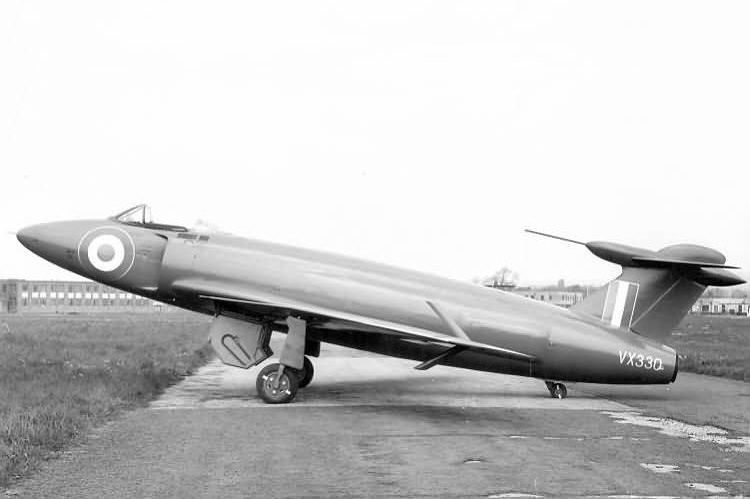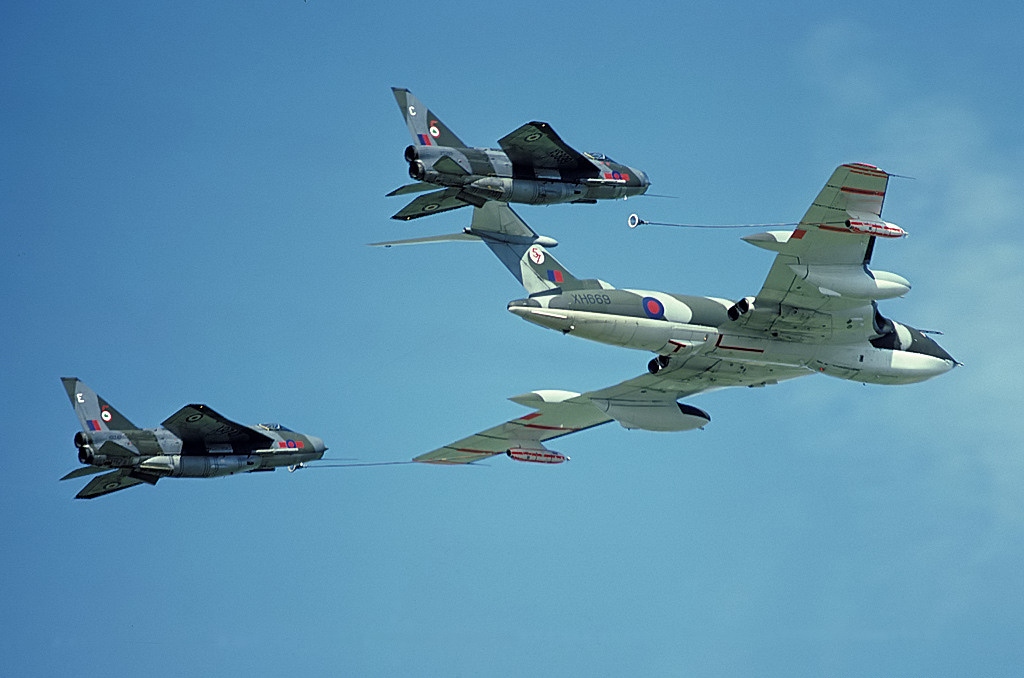

The Victor came during a pivotal point in British military history. With a fleet of piston engine bombers such as the Avro Lancaster and the Avro Lincoln, combined with the development of the British atomic program, the Royal Air Force was in need of a new line of strategic jet bombers, particularly to provide a deterrent against the growing power of the Soviet Union. The result was a series of submitted designs for new jet bombers. Handley Page’s proposal, developed in response to Operational Requirement OR.230, which called for a long-range bomber with a 2,000 nautical mile (2,300 mi; 3,700 km) radius of action at a height of 50,000 ft (15,000 m), a cruising speed of 575 miles per hour (925 km/h), and a maximum weight of 200,000 lb (91,000 kg) when fully loaded. Handley Page’s submission, the HP.80, was designed with a crescent-shaped swept wing developed by HP’s German-born aeronautical engineer Dr. Gustav Lachmann and his deputy Godfrey Lee. Handley Page also made a testbed for the HP.80’s wings out of a heavily modified Supermarine Attacker that was called the HP.88. However, the HP.88 program came to an abrupt end when the aircraft disintegrated in mid-air during a practice flight where it exceeded the structural integrity following severe pitching oscillation.

By 1952, the first two partially completed HP.80 prototypes, WB771 and WB775, were being built at the Handley Page factory at Radlett Airfield when the Ministry of Supply decided the runway was too short for the first flight, so the massive parts were transported by road to RAF Boscombe Down to be assembled for the first flight. On December 24, 1952, Handley Page’s chief test pilot Hedley Hazelden took the HP.80 for its maiden flight in WB771, which lasted for a total of 17 minutes. Just ten days later, it was announced by the Air Ministry that the HP.80 would officially be named the Victor.
After further development was carried out, the first Handley Page Victors entered operational service with the Royal Air Force’s in April 1958. Together with the Avro Vulcan and the Vickers Valiant, the Victor would become one of the three V-Bombers deployed by the Royal Air Force during the 1950s and 1960s, standing guard along with their American contemporaries such as the Boeing B-52 Stratofortress in case the Cold War went hot. The Victors would be equipped to carry some Britain’s most fearsome nuclear weapons, such as the Red Beard tactical nuclear bomb and the Blue Steel stand-off nuclear missile, designed to be air launched from a V-bomber and propelled by a rocket to its target. In July 1965, nine B.2 Victors converted for strategic reconnaissance were introduced into the RAF inventory to replace Vickers Valiants which had been withdrawn due to wing fatigue. Eventually, the Valiant would be retired from service altogether by 1965, leaving just the Vulcan and the Victor in service. The Victor also made history on June 1, 1956, when test pilot Johnny Allam exceeded the speed of sound in a Victor B.1, RAF serial number XA917, during a test flight. Allam’s instruments indicated that he reached Mach 1.1 during the shallow dive and local ground observers reported hearing a sonic boom, making the Victor the largest aircraft at that time to fly faster than the speed of sound.
With a change in tactics from high-level bombing to low-level bombing following the Soviet development of surface-to-air missiles (SAMs), and the retirement of the Valiants from service, the Victor would come to take over a role originally filled by the aging Valiant; that of aerial refueling tanker. This was also rather timely, as like the Valiant, low-level, high-speed exercise had caused wing fatigue in the Victors as well. In addition, the Royal Navy’s submarine fleet would become Britain’s main line of nuclear deterrence with the adoption of the American-built Polaris ballistic missile, that could be launched while a submarine was still submerged, and finally, the adoption of new strike aircraft such as the SEPECAT Jaguar and the Panavia Tornado during the 1970s led to the gradual retirement of the Victors and the Vulcans, but not before they would see some action in the latter days of the Cold War.

In 1982, Argentina invaded the British-owned Falkland Islands, which while much closer geographically speaking to Argentina, where the islands are called Las Malvinas, were almost entirely populated by British subjects. Thus, the British government would send its armed forces some 11,000 miles to force the Argentines from the islands. But with the Argentinians occupying the Port Stanley Airport, British strategists feared that the airport could be used to launch air attacks against the British naval taskforce. As such, it was decided to launch a daring raid using Avro Vulcans refueled by Handley Page Victors to disable the runway at Port Stanley. The problem was that the nearest outpost the British could launch an attack from was Ascension Island, situated in the middle of the South Atlantic, with a round trip of 6,500 nautical miles and 16 hours, which approached not only the maximum endurance of the Vulcans but of the Victors as well. During Operation Black Buck, the Victor tankers refueled each other in stages before refueling the attacking Vulcan, then repeated this process on the return leg of the mission, after the Vulcan had successfully struck the Port Stanley Airport’s runway. Though the runway itself was soon repaired for Argentine transports, it could not be used for fighter operations for the rest of the war, and with the withdrawal of their carrier taskforce, the Argentines were forced to fly their fighters from coastal air stations on the Argentine mainland.
In 1991, during the Iraqi invasion of Kuwait, the Victor tankers would go to war yet again, with eight being flown to Bahrain to support the coalition air forces during the Gulf War, with British Tornadoes receiving fuel from the Victors before going deep into Iraqi airspace on strike bombing runs. With the Gulf War’s swift conclusion, however, the last of the V bombers, the Handley Page Victor, was at last retired in 1993 favor of newer refueling tankers based off civilian airliners, such as the Lockheed Tristar and the Vickers VC 10. Today, four out of the 86 Handley Page Victors survive. B.1A XH648 is displayed at the Imperial War Museum Duxford, in Cambridgeshire, K.2 XH672 Maid Marian is in the National Cold War Exhibition of the Royal Air Force Museum Midlands in Cosford, Shropshire. The prototype for the conversion from the B.2 bomber to the K.2 tanker, K.2 XL231 Lusty Lindy is at the Yorkshire Air Museum in York, and finally, K.2 XM715 Teasin’ Tina/Victor Meldrew, which was the last Victor to conduct fast taxi demonstrations, is part of the Bruntingthorpe Cold War Jets Museum at Bruntingthorpe Aerodrome in Leicestershire.
The Handley Page Victor stands in the annuals of British aviation history as one of its longest-serving combat aircraft since WWII. It is also the culmination of Handley Page’s work in building bombers for the Royal Air Force, starting with the Type O of WWI, continuing into WWII with the Halifax, and ending up with the Victor, which would have far exceeded the words of Sir Murray Sueter, who in WWI prompted the development of the Type O by calling for “a bloody paralyzer of an aircraft”. It is quite fitting, then, that Handley Page should build what would be the last of the British strategic heavy bombers, even if it ended its career as a tanker, fueling the more modern aircraft that would endure to serve beyond the Cold War.
Today in Aviation History is a series highlighting the achievements, innovations, and milestones that have shaped the skies. All the previous anniversaries are available HERE






































